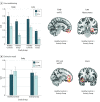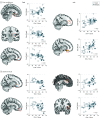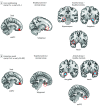Skin Conductance Responses and Neural Activations During Fear Conditioning and Extinction Recall Across Anxiety Disorders
- PMID: 28403387
- PMCID: PMC5539837
- DOI: 10.1001/jamapsychiatry.2017.0329
Skin Conductance Responses and Neural Activations During Fear Conditioning and Extinction Recall Across Anxiety Disorders
Abstract
Importance: The fear conditioning and extinction neurocircuitry has been extensively studied in healthy and clinical populations, with a particular focus on posttraumatic stress disorder. Despite significant overlap of symptoms between posttraumatic stress disorder and anxiety disorders, the latter has received less attention. Given that dysregulated fear levels characterize anxiety disorders, examining the neural correlates of fear and extinction learning may shed light on the pathogenesis of underlying anxiety disorders.
Objectives: To investigate the psychophysiological and neural correlates of fear conditioning and extinction recall in anxiety disorders and to document how these features differ as a function of multiple diagnoses or anxiety severity.
Design, setting, and participants: This investigation was a cross-sectional, case-control, functional magnetic resonance imaging study at an academic medical center. Participants were healthy controls and individuals with at least 1 of the following anxiety disorders: generalized anxiety disorder, social anxiety disorder, specific phobia, and panic disorder. The study dates were between March 2013 and May 2015.
Exposures: Two-day fear conditioning and extinction paradigm.
Main outcomes and measures: Skin conductance responses, blood oxygenation level-dependent responses, trait anxiety scores from the State Trait Anxiety Inventory-Trait Form, and functional connectivity.
Results: This study included 21 healthy controls (10 women) and 61 individuals with anxiety disorders (36 women). P values reported for the neuroimaging results are all familywise error corrected. Skin conductance responses during extinction recall did not differ between individuals with anxiety disorders and healthy controls (ηp2 = 0.001, P = .79), where ηp2 is partial eta squared. The anxiety group had lower activation of the ventromedial prefrontal cortex (vmPFC) during extinction recall (ηp2 = 0.178, P = .02). A similar hypoactive pattern was found during early conditioning (ηp2 = 0.106, P = .009). The vmPFC hypoactivation was associated with anxiety symptom severity (r = -0.420, P = .01 for conditioning and r = -0.464, P = .004 for extinction recall) and the number of co-occuring anxiety disorders diagnosed (ηp2 = 0.137, P = .009 for conditioning and ηp2 = 0.227, P = .004 for extinction recall). Psychophysiological interaction analyses revealed that the fear network connectivity differed between healthy controls and the anxiety group during fear learning (ηp2 range between 0.088 and 0.176 and P range between 0.02 and 0.003) and extinction recall (ηp2 range between 0.111 and 0.235 and P range between 0.02 and 0.002).
Conclusions and relevance: Despite no skin conductance response group differences during extinction recall, brain activation patterns between anxious and healthy individuals differed. These findings encourage future studies to examine the conditions longitudinally and in the context of treatment trials to improve and guide therapeutics via advanced neurobiological understanding of each disorder.
Conflict of interest statement
Figures





Similar articles
-
Multimodal Categorical and Dimensional Approaches to Understanding Threat Conditioning and Its Extinction in Individuals With Anxiety Disorders.JAMA Psychiatry. 2020 Jun 1;77(6):618-627. doi: 10.1001/jamapsychiatry.2019.4833. JAMA Psychiatry. 2020. PMID: 32022832 Free PMC article.
-
Association of Resting Metabolism in the Fear Neural Network With Extinction Recall Activations and Clinical Measures in Trauma-Exposed Individuals.Am J Psychiatry. 2016 Sep 1;173(9):930-8. doi: 10.1176/appi.ajp.2015.14111460. Epub 2016 Feb 26. Am J Psychiatry. 2016. PMID: 26917165
-
Failure of neural responses to safety cues in schizophrenia.Arch Gen Psychiatry. 2012 Sep;69(9):893-903. doi: 10.1001/archgenpsychiatry.2011.2310. Arch Gen Psychiatry. 2012. PMID: 22945619 Free PMC article.
-
Fear and safety learning in anxiety- and stress-related disorders: An updated meta-analysis.Neurosci Biobehav Rev. 2025 Feb;169:105983. doi: 10.1016/j.neubiorev.2024.105983. Epub 2024 Dec 18. Neurosci Biobehav Rev. 2025. PMID: 39706234 Review.
-
Impaired emotional learning and involvement of the corticotropin-releasing factor signaling system in patients with irritable bowel syndrome.Gastroenterology. 2013 Dec;145(6):1253-61.e1-3. doi: 10.1053/j.gastro.2013.08.016. Epub 2013 Aug 14. Gastroenterology. 2013. PMID: 23954313 Free PMC article. Review.
Cited by
-
Abnormal dynamic functional connectivity during fear extinction learning in PTSD and anxiety disorders.Mol Psychiatry. 2022 Apr;27(4):2216-2224. doi: 10.1038/s41380-022-01462-5. Epub 2022 Feb 10. Mol Psychiatry. 2022. PMID: 35145227 Free PMC article.
-
Fear-induced brain activations distinguish anxious and trauma-exposed brains.Transl Psychiatry. 2021 Jan 13;11(1):46. doi: 10.1038/s41398-020-01193-7. Transl Psychiatry. 2021. PMID: 33441547 Free PMC article.
-
A preliminary study of threat-anticipatory responding in Latina youth: associations with age, anxiety, and cortical thickness.Soc Cogn Affect Neurosci. 2024 Nov 19;19(1):nsae065. doi: 10.1093/scan/nsae065. Soc Cogn Affect Neurosci. 2024. PMID: 39563084 Free PMC article.
-
Fear extinction learning modulates large-scale brain connectivity.Neuroimage. 2021 Sep;238:118261. doi: 10.1016/j.neuroimage.2021.118261. Epub 2021 Jun 11. Neuroimage. 2021. PMID: 34126211 Free PMC article.
-
Neurocircuitry of Contingency Awareness in Pavlovian Fear Conditioning.Cogn Affect Behav Neurosci. 2021 Oct;21(5):1039-1053. doi: 10.3758/s13415-021-00909-6. Epub 2021 May 15. Cogn Affect Behav Neurosci. 2021. PMID: 33990933
References
-
- Yehuda R, LeDoux J. Response variation following trauma: a translational neuroscience approach to understanding PTSD. Neuron. 2007;56(1):19-32. - PubMed
Publication types
MeSH terms
Substances
LinkOut - more resources
Full Text Sources
Other Literature Sources
Medical

